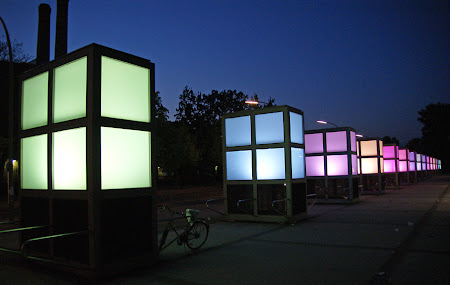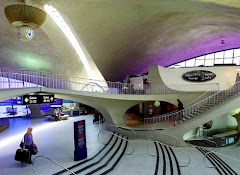Worksharing in Revit is a great tool but sometimes during workflow, you wish there was a specific tool to handle certain issues. One topic that used to come up is how do I know if someone has placed an editing request or am I working on the most updated version of the project? With Revit 2009, there are toolsets which provide these solutions. The Worksharing monitor will display any editing requests initiated by team members as well as notify you when a user on the team saves to central and when the last time that occurred. There is a catch however to this great tool. You must be on subscription!

Monday, March 24, 2008
Revit Architecture 2009: Worksharing
Friday, March 21, 2008
Revit Architecture 2009: Rendering
Revit Architecture 2009 has upgraded many features within its standard package. One being the render tool set. The developers and programmers at Autodesk, have updated the rendering engine to include Mental Ray along with a new interface in the rendering tab.
The changes made to the interface are more concise and well laid out. You still have the same options as previous versions of Revit but with more flexibility. If you are wondering how this effects certain workflows such as batch rendering or render farming, Autodesk has yet to include this option. You will still have to export out to another application for this purpose. Below are two images of the same scene from different angles. The first one rendered in Revit Architecture 2008 and the second one in Revit 2009. All settings are default with medium quality as the setting.
Revit 2008 with Accurender
Revit 2009 with Mental Ray
Wednesday, March 19, 2008
Green Architecture
The IES (Integrated Environmental Solutions Virtual Environment) toolkit helps to provide Revit users with the ability to perform an energy analysis that is pretty true to form. While Revit Architecture does hold the sun study tool, IES VE gives designers greater freedom and information in regards to sustainability of the project. In early stages of the design process, I would say anywhere from 50 to 80 percent of changes occur which can dramatically effect the energy output. The IES toolkit will formulate outputs for energy use, carbon use, solar studies, as well as many others. Below is an image of a small complex exported to IES. As you can see, you can set the model properties with building type, system, and place and location.
You can tell IES to calculate and create a building analysis in which calculations for areas for walls, floor, ceiling, glazing, and other surface areas will be displayed. You can also choose to view the model in various displays and walkthroughs. Once the model has been checked, you then select the check box "I have checked the model is suitable for analysis". Click OK
You can then select the Toolkit Icon and run a number of toolkits. For more information on the IES software, visit http://www.iesve.com/content/.
Monday, March 17, 2008
Customized Window Tags That Display Size
As you work in Revit, you may encounter times where the standard families do not suffice. In order to create your own families, you can start from scratch with a blank template, or you can start with an existing family and duplicate it and set it up with different parameters and functions.
1. Within any open file, select a window tag and on the options bar, select Edit Family.
2. This will open the family in another window. Go to File>SaveAs and rename this family at your discretion. For this example I will rename it “Window Size”. Remember to save the family in a network location so that others may access it.
3. In the drawing window, select the lines that make up the hexagon and delete them.
4. Select the parameter, the text piece labeled “1t”. Once you select it, a Select Parameter.. button will appear on the Options toolbar.
5. The Select Parameter dialog box will appear. In the Parameter category window, select Width and select the Format button
6. Uncheck Use Project Settings and switch the Units to Decimal Inches and make sure the Suffix is set to the inch marker. Click OK.
7. Back in the Select Parameter dialog, change the value to 32”. Click OK.
8. Highlight the text piece again and select the Element Properties button. Change the horizontal alignment to Right justification. This is done so that when data is entered, it will move to the left. Click OK.
9. Start the Copy command and copy the parameter over a few inches.
10. Select the right parameter and choose the Select Parameter button on the Options bar.
11. In the Select Parameter dialog box, change the Parameter option to Height. Set the Value to 32”, change the Format to Decimal Inches, and make sure the Suffix is set to the inch marker. Click OK twice to get back to the drawing.
12. Start the Text tool from the Family tab.
13. Place a text piece in between the two parameters and type in a lowercase x.
14. Highlight the “X” text piece and open the Element Properties.
15. In the Element Properties dialog, click on Edit/New and then Duplicate.
16. Give a new name to the text style. For exercise purposes, name the text “3-32”.
17. Change the Text Size to 3/32” and click OK twice to get back to the drawing.
18. In the drawing window, center the pieces so they align together.
19. Select the right parameter and make sure the Horizontal Alignment is set to Left within the Element Properties.
20. Go to File>Save. Close the drawing out.
Thursday, March 13, 2008
I've lost my DWG...now what?
So you say you drawing file was fine yesterday but today you can’t open it? Here are some simple tips that may help you open that file. First, search for the BAK file and rename the extension to DWG. If this doesn’t work, then find any temp file (auto.sv$) and rename the extension to DWG. Hey neither of these steps work! If this occurs, then open a new DWG file and insert the desired file and run the audit command (you may have to hit ESC numerous times as this will halt the regeneration process). Finally, if you have about given up, try the recover command.
Friday, March 7, 2008
...Comparing Apples to Oranges...umm Windows
Macs have come a long way since their inception on April 1st, 1976 . With Mr. Jobs' evangelist like approach, Apple's surge has helped creep its way further into the architecture world. A little over a year ago, Apple introduced its machines with the latest in Intel technology. This allowed Autodesk users to run their products via virtualization or Bootcamp.Of course there are advantages and disadvantages with Bootcamp and Parallels. In this post, I will primarily cover Parallels and how it interacts with Revit. First we need to get the specs out of they way. I currently run off of a Macbook Pro 17 inch Intel Core 2 Duo with 2 GB of memory and a NVIDIA graphics card at 256 VRAM.
Parallels has designed three different methods to run Windows and other platforms. Coherence, full screen, and single window are the three choices or views to select from. Running in coherence mode allows Windows apps to run while working in the Mac environment. Applications execute and populate as if they were in their own native setting.
Here is the setting with Parallels running in full screen. I particularly like this mode because it allows me to use a dual monitor set up where I can utilize both worlds. Depending on how you set this up, you can allow file sharing between the two platforms. I find this view to be best suited for those working with Revit and image/design applications such as the Adobe CS3 package.
Others tend to utilize the single window view. While this method allows you to control Windows programs, it corrals all applications within a single window, which can lead to confusion at some levels. In this mode you cannot maximize views and work efficiently while in Parallels. Below is an image of a single window view.
Finally we come to coherence view. This view works well when you do not have a dual monitor set up. This setting will allow users to execute Windows apps while in OS X. Notice that in this mode, you will be able to access and view the Windows start menu and bar.
No matter which view you work in, Parallels provides users the ability to work in a dual environment. In my experience, Revit has run at optimal performance while experiencing no latency. I am able to work with files in both platforms creating an efficient and productive workflow. If you are wondering about breaking the Autodesk EULA then no worries, I have been advised by Autodesk that it does not break support or license agreements!
Wednesday, March 5, 2008
Massings + (Paramerters * Formulas) = Arghh
Ever look at a design and wonder how the heck was that shape created? Revit Architecture can create many complex shapes through various different methods. One particular option can sometimes, and most of the time, drive a person mad. It feels as if you are the one sitting at the table with the March Hare and the Dormouse because when things don't make sense till you walk away. CHANGE PLACES !!!.
All kidding aside, the way Revit controls parametric formulas and functions are quite remarkable. As you create a simple massing element through the four different options (five now in 2009), it is relatively simple to extrude, sweep, blend, and revolve. What if you need something a little more dynamic. This is where parametric formulas take over. I will use a simple example to illustrate the steps in creating a massing model. I would like to thank Phil Read of Autodesk who has taught me the value of parametric formulas.
In this example I will be using reference lines rather than reference planes. Reference lines give me the option to control planes at four different levels. Please note that this is not a standard way of using parametric formulas but it does give a more basic insight of how these are created.
1. I started a new massing component family and placed in two reference lines extending into the first quadrant from the origin point. I then dimensioned and labeled each A1 and A2 respectively. (These helped to define the Angles of the reference line)
2. Then I created a blended form with my massing tool. When executing the bottom or top of the blend, make sure you set the work plane and select the reference line to which the bottom or top will be associated with. As each sketch is created, I dimensioned them equally and set a Width1 parameter for the bottom sketch and Width2 for the top.
3. Finish the sketch. Go into a 3D view and select the mass and choose edit base. Add vertex connectors and selected the lower left vertex of each face. This rationalizes the form into flat surfaces. Once that is complete, select the mass again and in the element properties, set the value of the First End to Base 1 and Second End to Base 2. This can be done through the radio button.
4. Add parameters: (All are instance parameters)
- Level# (Shared property and an integer)
- Height
- Width
- Linear Change Per Level
- Angular Change Per Level (Should be an Angle parameter)
5. I then entered in my formulas for each category to control the model itself. See below
6. I then saved the family and loaded it into a project that I had open at the time. Place the component or family into the project but make sure you select level 1 with the workplane tool. Use CTRL + C to create copies and select "paste aligned" through the Edit pulldown and select "same place". Create as many instances as you want.
7. Create a new mass schedule and only select the Level# parameter to add. You can the sort by Level # and click OK to create the schedule. Select each row and add in ascending numeric values. Open a 3D view and you should see your model. 
Monday, March 3, 2008
Revit Architecture 2009: Sweep and Blend You Say?
 With the dawn of Revit Architecture 2009, many new features have crept into the BIM platform, thus creating a frenzy among some in the AEC field. As I started Revit 09, I was quickly thrown back to the days of yore. Like my childhood where I would obtain the latest and greatest in gaming, I would discard the manual. I just wanted to play the darn game and learn the old fashion way. 25 plus years later, I am still in that scenario only now its with Revit.
With the dawn of Revit Architecture 2009, many new features have crept into the BIM platform, thus creating a frenzy among some in the AEC field. As I started Revit 09, I was quickly thrown back to the days of yore. Like my childhood where I would obtain the latest and greatest in gaming, I would discard the manual. I just wanted to play the darn game and learn the old fashion way. 25 plus years later, I am still in that scenario only now its with Revit.
As with all the new tools incorporated in this release, I will try to cover them in subsequent blogs. Today's feature is the Sweep and Blend tool. Have you ever created a spiral staircase and wonder how to get a wall to wrap around the stringer? Ever think there has got to be an easier way to do this? Well in Revit 2009 there is. The swept blend tool combines sweeping and blending into one paint brush so to speak.
There are many different ways to create a wall for the staircase and here is one option. After placing my spiral staircase into the project, I then decided to create an in-place wall family. I selected the outer edge of the right stringer as my 2D path. Then I selected the mass tool with the option of Sweep/Blend (Notice the sketch toolbar is a little different in this mode). I then selected the Sketch Profile 1 for the initial profile and clicked Finish. Same set of steps for the Sketch Profile 2. You can modify the settings for the profile as you could with the previous mass/void settings.
Once the properties were set for the wall, I finished the mass and created the rendering below. This tool allows Reviteers greater flexibility, efficiency, and functionality to create components within their model.








